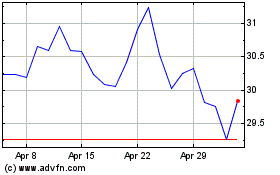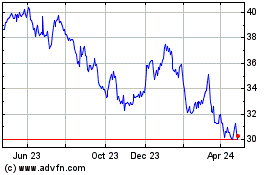Roche's Product Growth on Track, Biosimilars Erode European Sales -- Earnings Review
February 01 2018 - 9:45AM
Dow Jones News
By Sonia Amaral Rohter
Roche Holding AG (ROG.EB) on Thursday reported its full-year
results. Here is how the results came in:
SALES: The Swiss pharmaceuticals company had sales of 53.3
billion Swiss francs ($57.15 billion) in 2017, up from CHF50.58
billion a year earlier. Analysts had expected sales of about
CHF53.15 billion, according to a consensus forecast provided by
FactSet.
EARNINGS: Net profit for 2017 was CHF8.63 billion, down from
CHF9.58 billion in 2016. Core operating profit increased 3.2% to
CHF19.01 billion.
WHAT TO WATCH:
U.S. TAX REFORM: Roche said changes to the U.S. tax rate would
help earnings in 2018. The company expects high single-digit growth
in core earnings per share, compared with growth "broadly in line
with sales" when the effects of U.S. tax reform are excluded. Roche
forecast sales growth of "stable to low single digits at constant
exchange rates" for 2018. The change in the U.S. tax rate resulted
in a transitional expense of CHF116 million in 2017, Roche said. If
the new rates had applied for all of 2017, the effective core tax
rate would have been in the low twenties in percentage terms, Roche
said, excluding any transition impact. Roche's actual core
effective tax rate in 2017 was 26.6%.
HEMLIBRA: Roche said that Hemlibra has had "promising uptake" in
the U.S. and reported sales of CHF3 million for the year. Roche
launched Hemlibra, a hemophilia treatment, after FDA approval in
November. The hemophilia field is increasingly competitive and
analysts have high expectations for Hemlibra sales.
IMPACT FROM BIOSIMILARS: With several of Roche's blockbuster
drugs facing competition from cheaper copycats, the topline impact
of biosimilars was a source of concern. Biosimilar competition had
a noticeable impact in Europe, where Roche called competition from
MabThera/Rituxan copycats a "major driver" of sales decline in
2017. Sales of the cancer treatment grew 1% globally at constant
currency but fell 11% in Europe following the entry of biosimilars
into some markets in mid-2017. Roche expects MabThera/Rituxan
biosimilars to launch in the U.S. market later this year.
NEW PRODUCT GROWTH: Roche is relying on new products to offset
declining sales of some legacy drugs. Analysts were particularly
interested in the performance of Ocrevus, a treatment for multiple
sclerosis, and Tecentriq, a cancer immunotherapy. Together with
Alecensa, another cancer drug, they contributed CHF1.4 billion of
new sales in 2017, representing 65% of pharmaceuticals division
growth, Roche said. Full-year sales of Tecentriq more than tripled,
while Alecensa's doubled. Ocrevus, which launched last year,
brought in CHF869 million in sales in 2017 and "now has over 5%
market share of the U.S. multiple sclerosis market, an impressive
feat after just three quarters of sales," analysts at Berenberg
said.
Write to Sonia Amaral Rohter at
sonia.amaralrohter@dowjones.com
(END) Dow Jones Newswires
February 01, 2018 09:30 ET (14:30 GMT)
Copyright (c) 2018 Dow Jones & Company, Inc.
Roche (QX) (USOTC:RHHBY)
Historical Stock Chart
From Mar 2024 to Apr 2024

Roche (QX) (USOTC:RHHBY)
Historical Stock Chart
From Apr 2023 to Apr 2024
